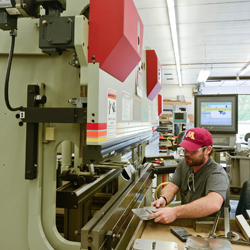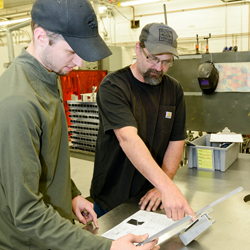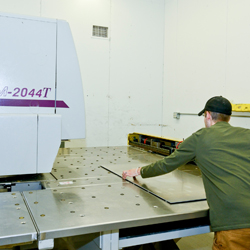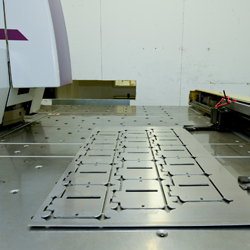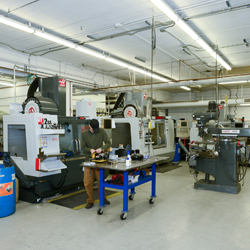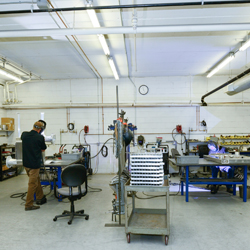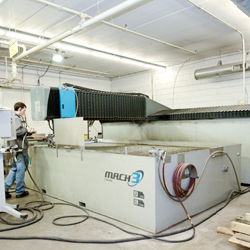Continuous Improvement
Welding and fabrication specialists Weld-Kraft attain continuous improvement, standardization and consistency with RADAN and Radbend
When it comes to thriving in an ever-changing industry, growth is on the mind of every manufacturer.
And while expansion and diversification are always worthwhile goals, sometimes the simplest means of boosting efficiency is to be better at what you’re already doing.
Such is the case with Weld-Kraft, a welding and fabrication business founded in 1979 and purchased by owner Don Mohs in 1996. Based in St. Louis Park, Minn., Weld-Kraft is a contract-manufacturing shop that specializes in custom-fabricated products and serves the military, commercial, food and medical industries, among others.
“The business has changed over the years, but mostly it’s just expanded,” says the affable Mohs of his company, which also offers support for new product development, cost reduction analysis, design for manufacturing, and manufacturing process improvement services.
From processing equipment to pneumatic and air systems for a range of uses, Weld-Kraft is adept in designing and manufacturing state-of-the-art products and solutions for clientele. Its military products include small, non-destructive parts, such as small fuel brackets and casings for electrical components.
While the majority of work is manufactured in stainless steel and aluminum, the shop also deals in a range of exotic metals.
“Our value added is the quality of our welding,” Mohs says. “What we do differently from other job shops is that we do design, support and fabrication. Our engineering assistance enhances fabrication capabilities to reduce costs and manufacture great products.”
To produce its range of custom products, Weld-Kraft acquired the RADAN and RADAN Radbend computer-aided-manufacturing (CAM) solutions, by Vero Software, in 2013. Today, Weld-Kraft uses RADAN to program its Murata Motorum 2044T turret punch press and RADAN Radbend to program its Accurpress press brake. The company works with Gladwin Machinery, a U.S.-based supplier of new and used fabrication equipment that meets all of Weld Kraft’s fabrication needs.
When it comes to thriving in an ever-changing industry, growth is on the mind of every manufacturer.
And while expansion and diversification are always worthwhile goals, sometimes the simplest means of boosting efficiency is to be better at what you’re already doing.
Such is the case with Weld-Kraft, a welding and fabrication business founded in 1979 and purchased by owner Don Mohs in 1996. Based in St. Louis Park, Minn., Weld-Kraft is a contract-manufacturing shop that specializes in custom-fabricated products and serves the military, commercial, food and medical industries, among others.
“The business has changed over the years, but mostly it’s just expanded,” says the affable Mohs of his company, which also offers support for new product development, cost reduction analysis, design for manufacturing, and manufacturing process improvement services.
From processing equipment to pneumatic and air systems for a range of uses, Weld-Kraft is adept in designing and manufacturing state-of-the-art products and solutions for clientele. Its military products include small, non-destructive parts, such as small fuel brackets and casings for electrical components.
While the majority of work is manufactured in stainless steel and aluminum, the shop also deals in a range of exotic metals.
“Our value added is the quality of our welding,” Mohs says. “What we do differently from other job shops is that we do design, support and fabrication. Our engineering assistance enhances fabrication capabilities to reduce costs and manufacture great products.”
To produce its range of custom products, Weld-Kraft acquired the RADAN and RADAN Radbend computer-aided-manufacturing (CAM) solutions, by Vero Software, in 2013. Today, Weld-Kraft uses RADAN to program its Murata Motorum 2044T turret punch press and RADAN Radbend to program its Accurpress press brake. The company works with Gladwin Machinery, a U.S.-based supplier of new and used fabrication equipment that meets all of Weld Kraft’s fabrication needs.
“Before CAM software, any time you used a turret punch, it did have a small post processor in it that you could use to direct the X and Y axes,” Mohs said. “It was very slow and archaic, and having RADAN was a big improvement.”“Before Radbend, you would have to manually take the press brake through all the bends. For a four-sided part, you would have to manually select punch and die, et cetera. Radbend makes it much quicker and faster, and you can tweak it to make it do what you want.”
Don Mohs, owner
Mohs had been familiar with RADAN prior to acquiring the software, but realized that he could further increase efficiency by also adopting Radbend.
“The reason we got Radbend is that continuous improvement is something that we want to have, but we also want to keep things standardized,” Mohs says. “We were trying to find uniformity, consistency, and knowledge.”
With Radbend, Mohs and his team are able to generate accurate 3D-model simulations of the bending process. They can also take advantage of advanced capabilities, including automatic bend-sequence calculation, automatic tool selection, and automatic finger-stop placement.
To begin a job in Radbend, Kyle Riendeau — programmer, fabricator, machinist and “superhero,” as proclaimed by Mohs — typically imports a solid model into Radbend. The software is able to import data in a range of 2D and 3D formats, and offers plug-in interfaces for popular 3D computer-aided-design (CAD) systems.
As Weld-Kraft uses the SOLIDWORKS® CAD solution, by Dassault Systèmes, to create new designs and make changes to existing files, it utilizes Radbend’s SOLIDWORKS plug-in to streamline interaction between the two solutions. The Radbend plug-in allows users to click on the Radbend icon within the SOLIDWORKS interface to easily transfer drawings and associated files into Radbend.
“It’s so easy to export the part from SOLIDWORKS into Radbend,” Riendeau says. “All I have to do is click the icon and it does all of the work for you.”
By programming and verifying bending operations offline, the company maximizes machine time and improves first-off part quality, which equates to a reduction in manufacturing costs.
Once the solid model is imported into Radbend, Riendeau selects his tools and material, and exports the data onto a flash drive. The flash drive is then given to Jason Sheeley, press-brake fabricator and “superman,” as titled by Mohs.
Sheeley then plugs the flash drive into the press brake, and the manufacturing begins.
“You can plug almost anyone into the brake press and they can go in there and start forming — to a degree,” Mohs says, adding that skilled employees always retain their value. “Radbend brings us closer to being able to make the part by giving Jason those four or five steps with less work and less waste of material.”
While Sheeley was not employed by Weld-Kraft before the company implemented CAM software, he has run the press brake with and without Radbend, and notes significant differences.
“With Radbend, I can grab the USB from Kyle and the first part is pretty close,” he says. “We’re also twice as fast in the setup with the software, as compared to the manual process. The software gives you the 3D image of the part that is formed on the screen and that can help you with the direction of the bend.”
While Sheeley still has to manually load the dies, the software delivers enough flexibility for him to make changes while removing much of the guesswork and error from the process.
“Before Radbend, you would have to manually take the press brake through all the bends,” Mohs says. “For a four-sided part, you would have to manually select punch and die, et cetera. Radbend makes it much quicker and faster, and you can tweak it to make it do what you want.”
Mohs and his team also rely upon Radbend’s collision-detection capabilities to solve problems before the job is sent to the press brake.
“If you have a complicated part, it will tell you if it will work beforehand,” Riendeau says. “That saves a lot of time.”
For the team at Weld-Kraft, which seeks continuous improvement, adopting RADAN and Radbend was the right choice because Vero’s RADAN team is dedicated to improving the software as machinery and the demands of customers grow ever-more sophisticated.
“They’re always taking customer ideas and improving upon them, and that’s always a good thing,” Riendeau says.
About the Company
Name: Weld-Kraft
Business: Welding and fabrication specialists
Web: weldkraft.com
Benefits Achieved
- Collision-detection capabilities to solve problems before the job is sent to the press brake
- Better framework for standardization and consistency
- Increased programming, setup and production efficiency
Comments
“Before Radbend, you would have to manually take the press brake through all the bends. For a four-sided part, you would have to manually select punch and die, et cetera. Radbend makes it much quicker and faster, and you can tweak it to make it do what you want.”
Don Mohs, owner









